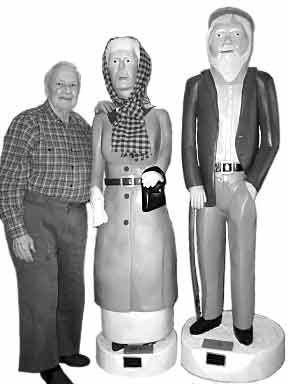

|
V8N14
- June 21-July 18, 2010:
“I
decided that because I have lived in the area and because
Warren may be starting a museum or something that they would
feel at home there. These carvings represent pioneers, which
came to Manitoba by ox-cart and settled.” Warren
Breyfogle was born on his grandparent’s farm in Union
Point Manitoba (a place Warren says used to exist between
Ste. Agathe and Morris on highway 75). It was called Union
Point because the Paddle Boat and Stage Coach stopped there
(on the Red River). If you go there today you can still see
tracks that the stage coach cut into the ground 100 years
ago. Warren
lived in Union Point with his family until 1938 (except for
a few years that the family spent in Chicago from 1924-28).
In 1938 his Father and Grandfather built a new homestead on
a farm in the same area. Warren
attended the proverbial “one room school house”
where one teacher taught 36 children, (every grade from 1-8)
and graduated from grade 8 when he was 13 years old. He proudly
states, “I never had a day of high school.” His
many skills are mainly self-taught and it sounds like he has
always been a very creative and industrious person. Warren
started running the family farm when he was 14 and joined
the Air Force when he was 20. There, he worked as an aero-engine
mechanic until the end of the 2nd World War, in 1946. After
the war, Warren qualified to attend University and got his
diploma in Agriculture at the University of Manitoba. After
University, Warren went back to his family farm, got married
to Joyce Gluck in 1951 and raised 7 children with her. In
1953 his brother took over the farm and Warren moved to Winnipeg
where he went into “sales” which caused him to travel
extensively. When Joyce
fell ill and had to be hospitalized for a year, Warren stayed
closer to home to care for his children. Eventually, Joyce
got out of the hospital and Warren purchased another farm
and moved the family to Rosser, Manitoba. “My wife just
loved gardening.” In Rosser he took a very active interest
in youth and sports. He helped to run recreation programs,
coached, organized field days, dances and skating evenings.
As he himself puts it, “I did it all!” Joyce
and Warren lived happily in Rosser, which he felt was “an
ideal place to raise and educate a family.” (Rosser is
located on the northwest boundary of Winnipeg.) In 1963,
he and Joyce retired, and they moved to a little cottage in
Sandy Hook from where they enjoyed traveling to distant lands.
They spent thirteen winters going to Texas where he started
carving at the age of 75 or so. “I took to it very well
and got a lot of satisfaction out of it,” he said. Eventually
Warren was approached by the seniors club at Gimli New Horizons
and was asked to consider becoming a carving instructor. This
worked out well with the carving group topping out at 25 people.
He also instructed several other programs and entered many
carving competitions winning in both Canada and the U.S. Eventually,
he limited himself to doing carving on consignment only and
over the years he has carved hundreds of pieces. At time
of writing in 2010 Warren is 88 years old and Joyce has passed
away. Warren now lives in Stonewall’s Lion’s Manor
and only does very “special” assignments. Warren
has had many interests over his lifetime and has been what
you might call a true Renaissance Man. He says that carving
is very “enjoyable, relaxing, and takes my full concentration”
and laughs, “it takes your mind off of all your problems.”
Now Warren gets most of his enjoyment in life by helping others. “I
carved these because I felt it was something that very few
people would or could do and I had something to prove to myself.”
Most of Warren’s other carvings are much smaller than
Miranda and Jeremiah and have been sold or given to friends
and family. “I decided that because I have lived in the
area and because the West Interlake Trading Company may be
starting an interpretive centre or something, that they would
feel at home there. These carvings represent pioneers, which
came to Manitoba by Ox-cart and settled in Vita.” In the
photo of Warren Breyfogle with Miranda & Jeremiah, the
two amazing pieces of hand-carved folk art were made from
one tree, cut down in 1998 on 5th Avenue in Sandy Hook. The
wood was left to season for 3 years before it was cut into
8-foot lengths and stored to season indoors for another 2
years. The carving was mainly done by chainsaw, with more
delicate finishing touches done by hand. They were left in
their natural state, mostly unpainted, until this past winter
when they were completed for the Grain Elevator Museum/Interpretive
Centre in Warren. Warren
states, “If things do not develop like I hope they will
in Warren, Miranda and Jeremiah are to be relocated.”
The Woodlands Pioneer Museum would be another great choice
for their home. To visit Warren’s larger than life carvings, come to the Warren Country Market & Grain Elevator. (Read
more in the Jun
21 -Jul 18/2010 issue of Senior Scope) |
|
Can you spot the Con Artist?Most of
us believe we could spot a con artist as we have preconceived
ideas of what they look like, how they walk, and more importantly
how they talk. But if identifying this type of criminal is
so easy then why do Canadians The truth
is anyone could be a con artist. If you think they are male,
mid- forties, well dressed, and well spoken, think again.
The only constant with con artists is they’re deceptive
and want your money. No matter what the pitch is the end result
will be a request or demand for your money either in the form
of cash, cheque, money order, or wire transfer. Although
most fraudsters complete their pitches over the phone or on
the internet some still prefer face to face interaction with
their victim. Unlike a thief who steals your wallet for its
contents, the con artist convinces you to hand over the contents.
They will say anything to build your trust and play on personal
information acquired from you in The following
are some of the more common red flags which may suggest you
are being conned: They
only want you to pay in cash: Legitimate businesses would
never refuse an alternate form of payment. You
only have today to get this “great deal”: A
common theme is pressure and they will try to get you committed
without thinking about it. Confidentiality
: Ask yourself, why does this deal have to be secret?
Be suspicious if you’re asked not to talk to anyone else
about it. If you’re
being offered a deal that is too good to be true, then it
probably is. If you’ve been approached by an unknown
person who claims to know you from the past or is a long lost
relative share this information with friends and family. Above
all, don’t part with your money or personal information
unless you’re absolutely certain you know who you’re
dealing with. Cst.
Ben Doiron (Read
more in the Jun
21 -Jul 18/2010 issue
of Senior Scope) |
|
Financial Planning Solutions Investing
for Cash flow
|
||||||||
|
|
||||||||||||
|
Publisher: Kelly Goodman
Phone: 204-467-9000
Box 1806 Stonewall
Manitoba, Canada
R0C 2Z0
Email: kelly_goodman@shaw.ca


